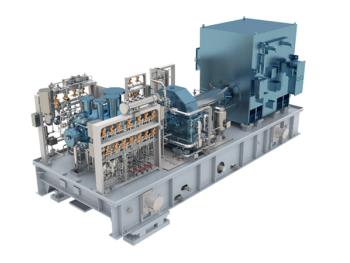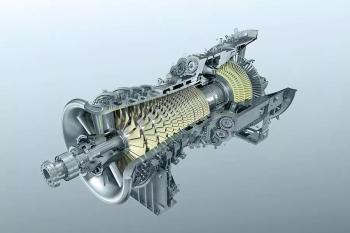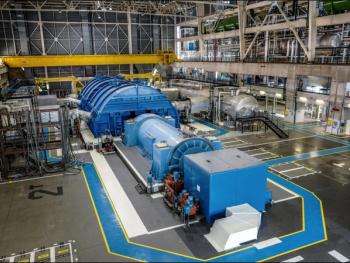
SPECIFYING LARGE HP MOTORS FOR COMPRESSORS
WHEN MOTORS ARE REQUIRED TO RUN LARGE COMPRESSORS, IT IS VITAL TO SPECIFY THEM CORRECTLY TO CONTAIN COSTS
For large centrifugal compressor applications, turbines will continue to be the prime mover of choice, but electrics have their place. When permits are not available or noise is a problem, an electric prime mover is required. So what are the cost drivers for a medium-voltage motors, and are we over specifying them?
The amount of horse power (HP) to start and run the load determines the frame size of the motor. Like most mechanical equipment, the frame is the main driver of cost. What is not always recognized, however, is that some specifications increase frame size (Figure 1).
Accurately determining the frame size begins with the power required to drive the load. But the next factor to consider is the enclosure, the second major cost driver.
The industry typically uses three types of enclosures:
• Weather Protected II (WPII) is an open motor with baffling and screening for protection against contaminants. It offers good cooling, the smallest frame and lowest cost. However, noise is an issue. Further, WPII is the least reliable motor when reviewed against performance during 20 years of service
• The next type of enclosure is Totally Enclosed Air to Air Cooled (TEAAC). It is cooled using a large air-to-air radiator on top of the motor. The outside air does not circulate through the motor, which is more reliable than WPII. The disadvantage is the lower efficiency of an air-to-air heat exchanger. It typically has to be specified one frame size larger than a WPII (Figure 2)
• The Totally Enclosed Water to Air Cooled (TEWAC) has a water-to-air heat exchanger in the motor which makes it more efficient than a TEAAC. It has shown to be the most reliable enclosure, but requires plant water. TEWAC is the favorite of motor designers with its low noise and good cooling. It is in the same frame as a similar-rated WPII.
In terms of costs, WPII is the least expensive, and requires the most maintenance. A TEWAC costs 10% to 15% more for the same power rating, while a TEAAC costs about 30% more. Exceptions are 2 pole or 3,600 RPM@60 HZ motors which are rarely used. WPII is not an option for these larger, high-speed motors due to high noise levels (Table 1).
Service factor
Service Factor is the percentage of overloading a motor can handle for short periods when operating normally within the correct voltage tolerances. Medium Voltage (MV) motors must be capable of continuous operation at the service factor and still meet all specifications, such as temperature rise. Therefore, a 1,000 HP motor with a 1.15 service factor is actually a 1,150HP motor.
API motor specifications for driven equipment no longer includes Service Factor. Reason: A 15% service factor generally increases the motor to the next largest frame size. Therefore, adding the typical 10% for the driven equipment and 15% for the motor would create a motor that is oversized by 26%. If the driven equipment has a service factor, users should consider eliminating the motor service factor.
The least understood specification is usually listed under starting requirements as 3C/2H or 2C/1H. This is the reference to how many times a motor can be started safely. The “C” refers to the number of times a motor can be started cold (motor temperature at ambient temperature) and the “H” the number of times it can be started hot (motor temperature above ambient but not exceeding its rated load temperature) per NEMA MG1 20.12.
API calls out 3C/2H, which means 3 cold (C) and 2 hot (H) starts. Having the ability to start 3 times in quick succession may be important for certain applications but it comes at a cost. The motor supplier will generally have to increase the frame size to handle the heat generated from each start. This is why some specifiers take exception to the API 3C/2H and only require 2C/1H.
Over the last 30 years, motor operating voltage has gone from 2,300 V to 4,160 V and now it is common for 13kV to be requested. As voltage rises for an electric motor, the insulation requirements for the winding also increase. At 10 kV, it is usually necessary to add corona shielding to insulation systems. That necessitates a larger frame to accommodate thicker insulation and enough copper to meet HP requirements.
Even if the incoming power is 13 kV, this may not be the best choice if costs are to be controlled. As well as the price of a second transformer for a 6 kV operation, cabling costs can add up. Similarly, switchgear is less expensive at 6 kV than 13 kV and has fewer safety requirements. For motors under 10,000 HP, therefore, operating at a lower voltage should be considered as a way to reduce CAPEX (Table 2).
When users give careful consideration to the above factors, however, they can still be tripped up by a long list of options and accessories. While these are generally not cost drivers for motors over 2,000 HP, they are important in smaller motors. Most options have the same cost at 500 HP as they do at 20,000 HP.
Standards, too, have to be considered. American Petroleum Institute (API) standards, for example, are designed to improve the reliability of the motor in long-term continuous service. Each company must evaluate that reliability against the cost equation.
For motors less than 10,000 HP, it can raise costs by two or three times. The usual practice is to make all large HP motors API compliant, but that may not always be necessary. For those applications that are not critical service, consider using API547 or API “light” which is lower cost and offers improved reliability over a standard industrial motor.
The amount of testing needed for a motor-compressor application is dependent on the application. Certain types of testing may be considered necessary, desirable or excessive, depending on the use. Many use API motor test sheets. Combined within the annex in the API standard, they give specific information on when and why to use a given test.
Types of testing terms:
• Routine test (to the manufacturer’s standard and typically included in the price) • Complete test (as defined by NEMA MG1 and API, done at a nominal cost to provide a baseline for operations as most parameters are measured)
• Witnessed test (probably not needed for a known supplier and product).
There are also tests for special applications which are detailed in API 541 and 546. Since many tests require additional time, add to cost and in some cases may be damaging to the motor, each must be considered according to its value for a given application (Figure 3).
One caution. The biggest problem for an electric application is failure to start due to a voltage drop or underestimating worst-case starting conditions. NEMA and API require the motor to be able to handle a 20% drop in voltage when starting.
Since torque drops with the square of the voltage, a 20% drop will yield a motor torque of 64%. In remote areas, the voltage drops of more than 20% are not uncommon. Therefore, confirm worst-case voltage drop and worst-case starting conditions at highest load as part of the evaluation process to ensure project success.
It is always good to turn to an independent source to make sense of conflicting vendor data. For those evaluating enclosure reliability, a good resource is IEEE paper PCIC- 2015-03, “Most Common Mechanism and Reasons for Electric Motor Failures in Petrochemical Industry.”
Author
James Nanney is Technical Sales Manager for Oil and Gas at TMEIC Corporation. For more information, visit www.tmeic.com
Newsletter
Power your knowledge with the latest in turbine technology, engineering advances, and energy solutions—subscribe to Turbomachinery International today.




